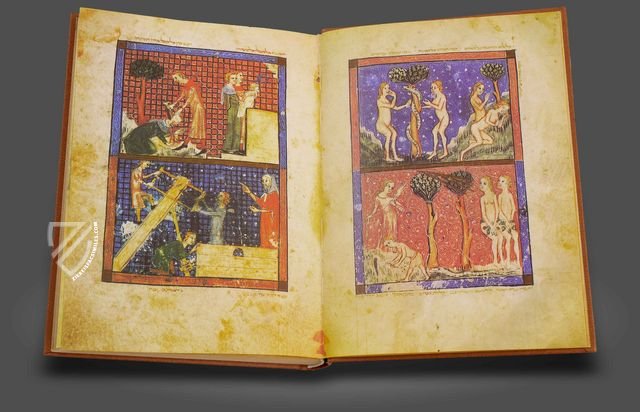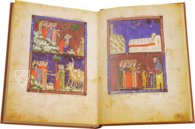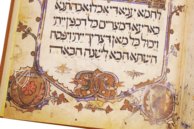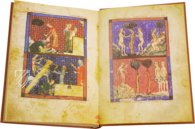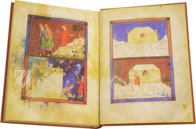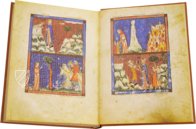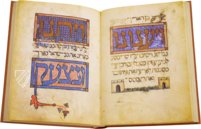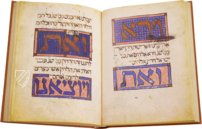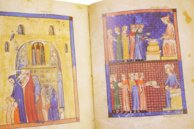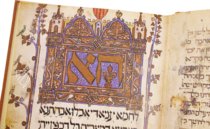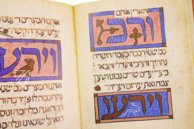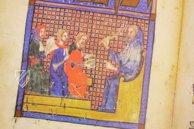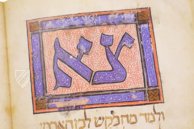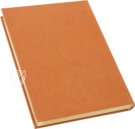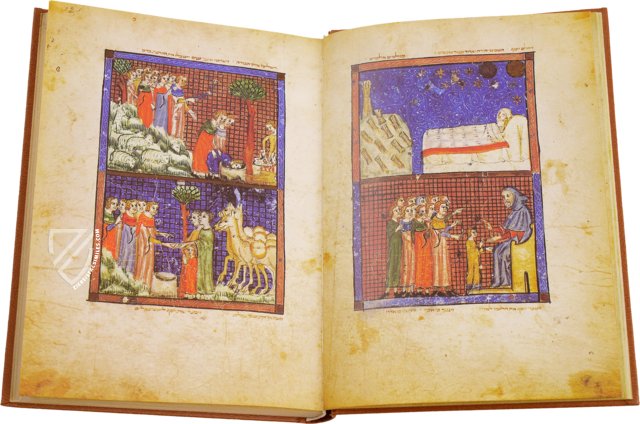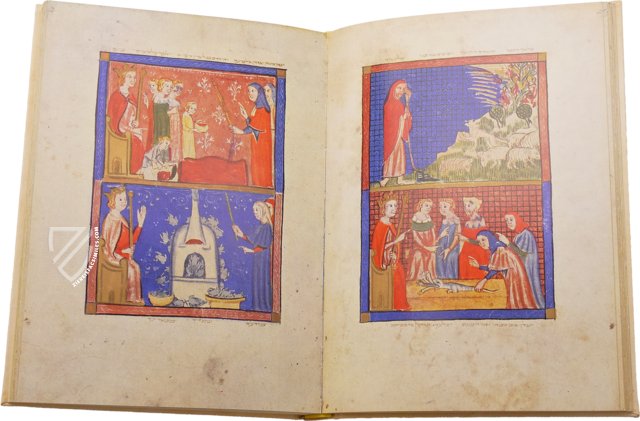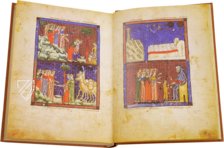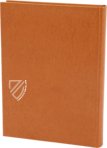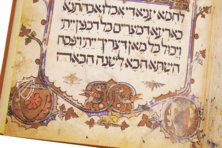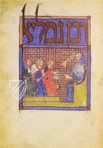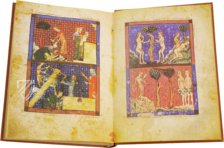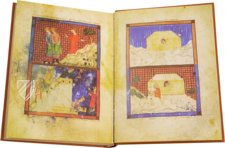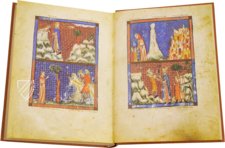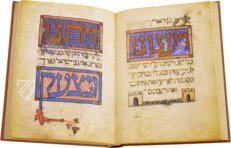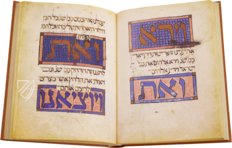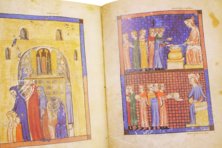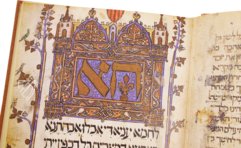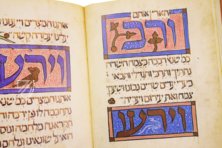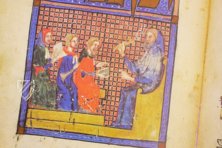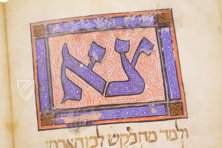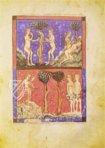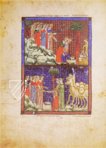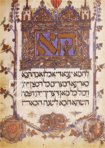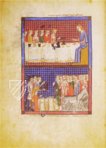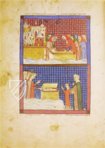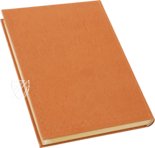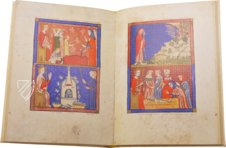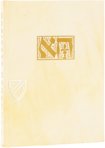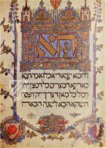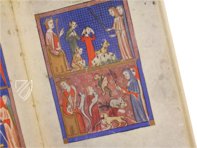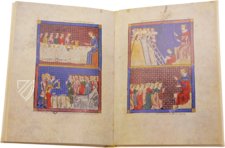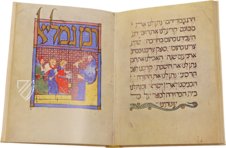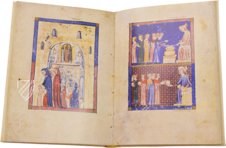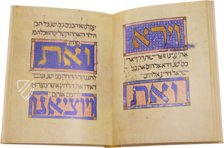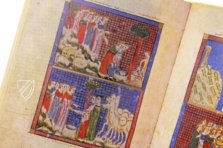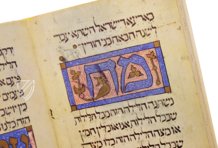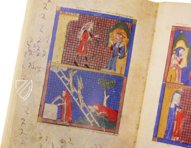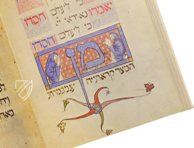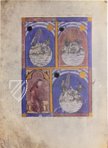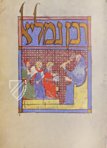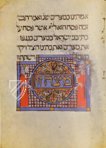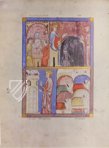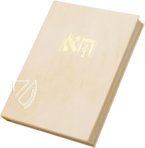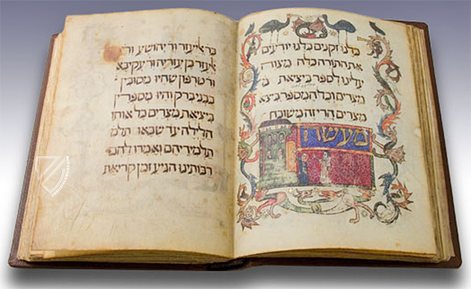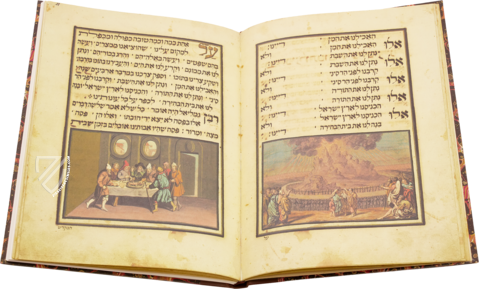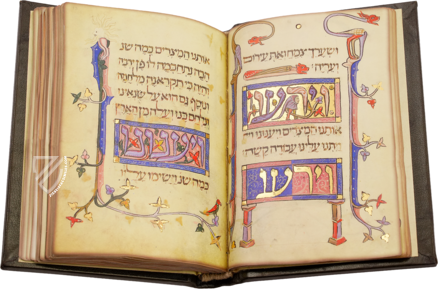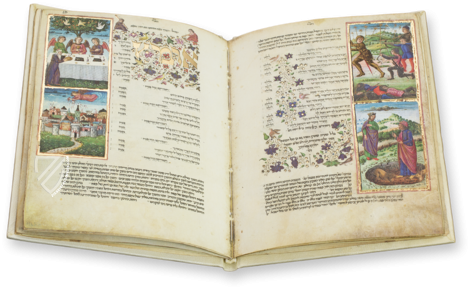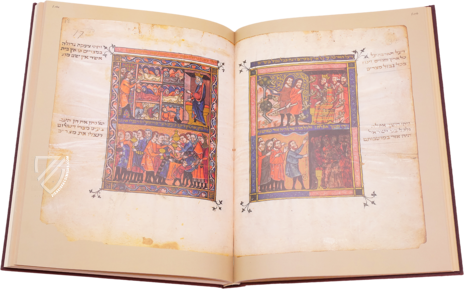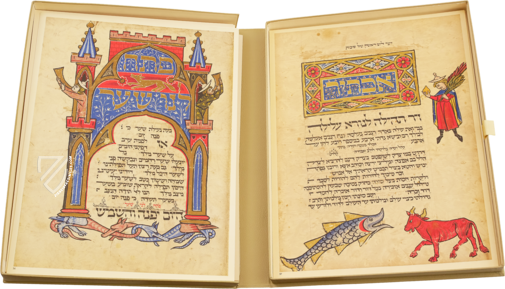Sarajevo Haggadah
(under 1,000€)
The Sarajevo Haggadah is one of the oldest Sephardic Haggadot in the world and probably originated around 1350 in Barcelona. It was created from bleached calfskin and was illuminated with 69 miniatures and numerous decorated initials and incipits, richly decorated with copper and gold. The first 34 pages of the book present impressive biblical scenes from Creation through the death of Moses, but the last four miniatures are secular in nature, which is exceptional. Wine stains on the pages also indicate that the manuscript was actually used at numerous Passover Sedarim. Furthermore, the manuscript has had a tumultuous history, having been nearly destroyed several times during World War II and the siege of Sarajevo in the 1990s, but has thankfully survived to the present day and was added to UNESCO's Memory of the World register in 2017.
Sarajevo Haggadah
Among the precious artifacts of medieval Judaica that have survived to the present, the Sarajevo Haggadah is one of the oldest and most beautiful. Created by Sephardic Jews living in Barcelona ca. 1350, the manuscript has had a tumultuous history, a long road that eventually led to the National Museum of Bosnia and Herzegovina. It was created using the finest calfskin and the 69 miniatures of the work, many of which have finely patterned backgrounds, are illuminated with gold and copper. Aside from telling the Passover narrative along with other Old Testament stories, it also offers precious glimpses of Jewish life in 14th century Spain.
Many Close Calls with Destruction
The Sarajevo Haggadah was presumably taken out of Spain in the aftermath of the Alhambra Decree, which expelled practicing Jews from the Crowns of Castile and Aragon in 1492. Marginal notes indicate that it was in Italy during the 16th century and the manuscript was sold to the National Museum in Sarajevo in 1894 by a certain Joseph Kohen. During World War II, the Museum's chief librarian, Derviš Korkut (1888–1969), risked his own life in order to hide it from the Nazis, who were in the process of pillaging art from across Europe. Korkut entrusted a Muslim cleric in a mountain village where it was hidden in a mosque. The manuscript survived another conflict decades later – the Bosnian War. After a museum heist in 1992, it was discovered by the police lying on the floor. Thankfully, the burglars did not recognize the value of the precious codex and left it behind. During the Siege of Sarajevo by Serb forces, it was safely stored in an underground bank vault. Restoration work on the manuscript began in 2001 and in 2002, a special vault room was dedicated to the Haggadah, where it occupies a central space surrounded by other important documents from the Orthodox, Catholic, and Muslim faiths. The Sarajevo Haggadah was added to the UNESCO Memory of the World Register in 2017.
Codicology
- Size / Format
- 328 pages / 22.8 × 16.5 cm
- Origin
- Spain
- Date
- Around 1350
- Epochs
- Language
- Script
- Sephardi square script
- Illustrations
- 69 miniatures and numerous decorated initials
- Content
- Texts for the ritual on Seder evening
- Previous Owners
- Sarajevan Sephardic family Koen
A mosque in a village on Mount Bjelašnica (during the II World War)
Sarajevo Haggadah
The Finding of Moses
At the end of chapter 1 in the Book of Exodus, Pharoah orders that every newborn Hebrew boy is to be thrown into the Nile and chapter 2 tells the story of how Moses was hidden among the reeds by his mother and later discovered by Pharoah’s daughter, who eventually adopts him. Rather than being depicted in a basket, Moses is exposed by the open lid of a box-like ark. The Egyptian princess, crowned and dressed in red, gestures towards the Hebrew woman that has been brought by her servant and offers to pay her to breastfeed and conceal the boy.
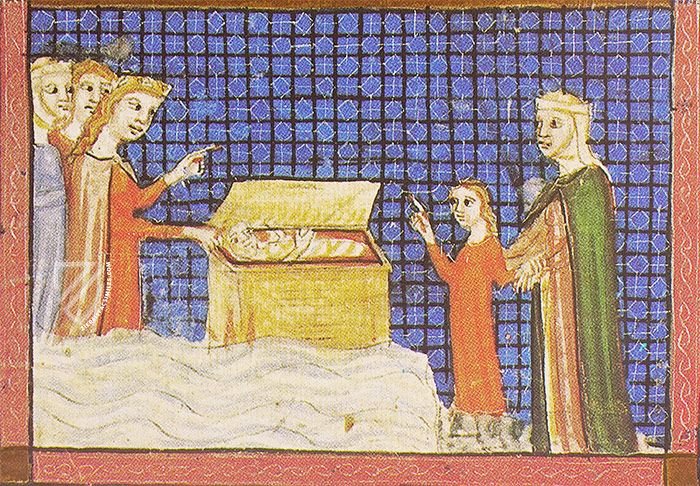
Sarajevo Haggadah
Gamaliel the Elder
In the Jewish tradition, Rabban Gamaliel, a Pharisee and leading authority in the Sanhedrin during the 1st century, is considered to be to be one of the greatest teachers in the history of Judaism and is remembered by Christians for his leniency towards the Apostles. Furthermore, the Book of Acts also claims that Paul the Apostle was educated by Gamaliel before his conversion, although the influence of his teachings on Christian theology remains unclear.
Framed with an incipit panel and a patterned red background, three students, two male and one female with a covered head, follow the teachings of their master and have their eyes fixed upon him. He is seated in a high-backed wooden chair gesturing rhetorically with one hand and holding a small multi-tailed whip with the other. This detail has led some to speculate that this is actually a miniature of his grandson, Rabban Gamliel II, who unlike his grandfather, was known for his severity.
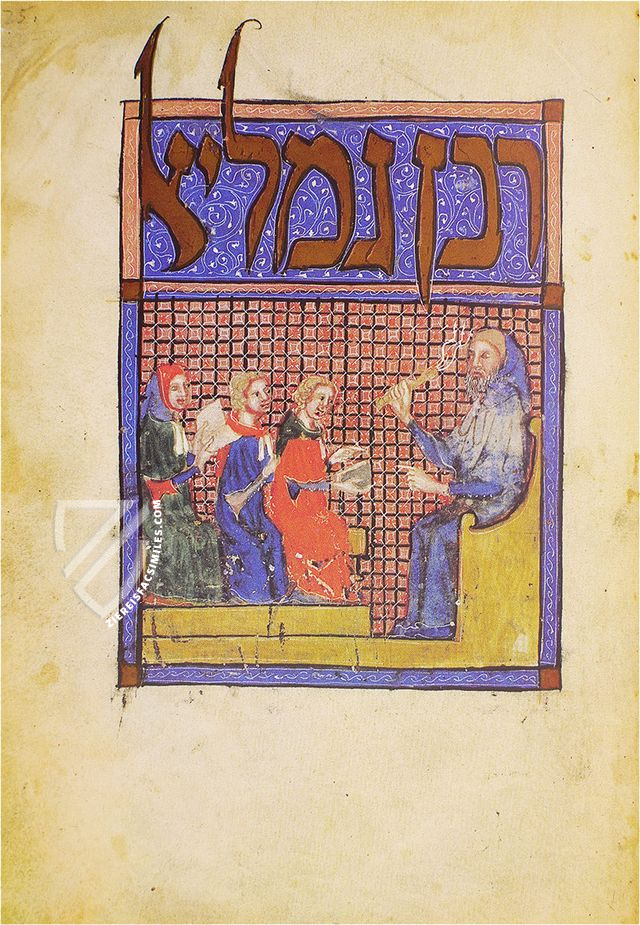
#1 The Sarajevo Haggadah
Language: English
(under 1,000€)
#2 The Sarajevo Haggadah
Language: Hebrew
(under 1,000€)
- Treatises / Secular Books
- Apocalypses / Beatus
- Astronomy / Astrology
- Bestiaries
- Bibles / Gospels
- Chronicles / History / Law
- Geography / Maps
- Saints' Lives
- Islam / Oriental
- Judaism / Hebrew
- Single Leaf Collections
- Leonardo da Vinci
- Literature / Poetry
- Liturgical Manuscripts
- Medicine / Botany / Alchemy
- Music
- Mythology / Prophecies
- Psalters
- Other Religious Books
- Games / Hunting
- Private Devotion Books
- Other Genres
- Afghanistan
- Armenia
- Austria
- Belgium
- Belize
- Bosnia and Herzegovina
- China
- Colombia
- Costa Rica
- Croatia
- Cyprus
- Czech Republic
- Denmark
- Egypt
- El Salvador
- Ethiopia
- France
- Germany
- Greece
- Guatemala
- Honduras
- Hungary
- India
- Iran
- Iraq
- Israel
- Italy
- Japan
- Jordan
- Kazakhstan
- Kyrgyzstan
- Lebanon
- Liechtenstein
- Luxembourg
- Mexico
- Morocco
- Netherlands
- Palestine
- Panama
- Peru
- Poland
- Portugal
- Romania
- Russia
- Serbia
- Spain
- Sri Lanka
- Sweden
- Switzerland
- Syria
- Tajikistan
- Turkey
- Turkmenistan
- Ukraine
- United Kingdom
- United States
- Uzbekistan
- Vatican City
- A. Oosthoek, van Holkema & Warendorf
- Aboca Museum
- Ajuntament de Valencia
- Akademie Verlag
- Akademische Druck- u. Verlagsanstalt (ADEVA)
- Aldo Ausilio Editore - Bottega d’Erasmo
- Alecto Historical Editions
- Alkuin Verlag
- Almqvist & Wiksell
- Amilcare Pizzi
- Andreas & Andreas Verlagsbuchhandlung
- Archa 90
- Archiv Verlag
- Archivi Edizioni
- Arnold Verlag
- ARS
- Ars Magna
- ArtCodex
- AyN Ediciones
- Azimuth Editions
- Badenia Verlag
- Bärenreiter-Verlag
- Belser Verlag
- Belser Verlag / WK Wertkontor
- Benziger Verlag
- Bernardinum Wydawnictwo
- BiblioGemma
- Biblioteca Apostolica Vaticana (Vaticanstadt, Vaticanstadt)
- Bibliotheca Palatina Faksimile Verlag
- Bibliotheca Rara
- Boydell & Brewer
- Bramante Edizioni
- Bredius Genootschap
- Brepols Publishers
- British Library
- C. Weckesser
- Caixa Catalunya
- Canesi
- CAPSA, Ars Scriptoria
- Caratzas Brothers, Publishers
- Carus Verlag
- Casamassima Libri
- Centrum Cartographie Verlag GmbH
- Chavane Verlag
- Christian Brandstätter Verlag
- Circulo Cientifico
- Club Bibliófilo Versol
- Club du Livre
- CM Editores
- Collegium Graphicum
- Collezione Apocrifa Da Vinci
- Comissão Nacional para as Comemorações dos Descobrimentos Portugueses
- Coron Verlag
- Corvina
- CTHS
- D. S. Brewer
- Damon
- De Agostini/UTET
- De Nederlandsche Boekhandel
- De Schutter
- Deuschle & Stemmle
- Deutscher Verlag für Kunstwissenschaft
- DIAMM
- Droz
- E. Schreiber Graphische Kunstanstalten
- Ediciones Boreal
- Ediciones Grial
- Ediclube
- Edições Inapa
- Edilan
- Editalia
- Edition Deuschle
- Edition Georg Popp
- Edition Leipzig
- Edition Libri Illustri
- Editiones Reales Sitios S. L.
- Éditions de l'Oiseau Lyre
- Editions Medicina Rara
- Editorial Casariego
- Editorial Mintzoa
- Editrice Antenore
- Editrice Velar
- Edizioni Edison
- Egeria, S.L.
- Eikon Editores
- Electa
- Emery Walker Limited
- Enciclopèdia Catalana
- Eos-Verlag
- Ephesus Publishing
- Ernst Battenberg
- Eugrammia Press
- Extraordinary Editions
- Fackelverlag
- Facsimila Art & Edition
- Facsimile Editions Ltd.
- Facsimilia Art & Edition Ebert KG
- Faksimile Verlag
- Feuermann Verlag
- Folger Shakespeare Library
- Franco Cosimo Panini Editore
- Friedrich Wittig Verlag
- Fundación Hullera Vasco-Leonesa
- G. Braziller
- Gabriele Mazzotta Editore
- Gebr. Mann Verlag
- Gesellschaft für graphische Industrie
- Getty Research Institute
- Giovanni Domenico de Rossi
- Giunti Editore
- Graffiti
- Grafica European Center of Fine Arts
- Guido Pressler
- Guillermo Blazquez
- Gustav Kiepenheuer
- H. N. Abrams
- Harrassowitz
- Harvard University Press
- Helikon
- Hendrickson Publishers
- Henning Oppermann
- Herder Verlag
- Hes & De Graaf Publishers
- Hoepli
- Holbein-Verlag
- Houghton Library
- Hugo Schmidt Verlag
- Idion Verlag
- Il Bulino, edizioni d'arte
- ILte
- Imago
- Insel Verlag
- Insel-Verlag Anton Kippenberger
- Instituto de Estudios Altoaragoneses
- Instituto Nacional de Antropología e Historia
- Introligatornia Budnik Jerzy
- Istituto dell'Enciclopedia Italiana - Treccani
- Istituto Ellenico di Studi Bizantini e Postbizantini
- Istituto Geografico De Agostini
- Istituto Poligrafico e Zecca dello Stato
- Italarte Art Establishments
- Jan Thorbecke Verlag
- Johnson Reprint Corporation
- Josef Stocker
- Josef Stocker-Schmid
- Jugoslavija
- Karl W. Hiersemann
- Kasper Straube
- Kaydeda Ediciones
- Kindler Verlag / Coron Verlag
- Kodansha International Ltd.
- Konrad Kölbl Verlag
- Kurt Wolff Verlag
- La Liberia dello Stato
- La Linea Editrice
- La Meta Editore
- Lambert Schneider
- Landeskreditbank Baden-Württemberg
- Leo S. Olschki
- Les Incunables
- Liber Artis
- Library of Congress
- Libreria Musicale Italiana
- Lichtdruck
- Lito Immagine Editore
- Lumen Artis
- Lund Humphries
- M. Moleiro Editor
- Maison des Sciences de l'homme et de la société de Poitiers
- Manuscriptum
- Martinus Nijhoff
- Maruzen-Yushodo Co. Ltd.
- MASA
- Massada Publishers
- McGraw-Hill
- Metropolitan Museum of Art
- Militos
- Millennium Liber
- Müller & Schindler
- Nahar - Stavit
- Nahar and Steimatzky
- National Library of Wales
- Neri Pozza
- Nova Charta
- Oceanum Verlag
- Odeon
- Orbis Mediaevalis
- Orbis Pictus
- Österreichische Staatsdruckerei
- Oxford University Press
- Pageant Books
- Parzellers Buchverlag
- Patrimonio Ediciones
- Pattloch Verlag
- PIAF
- Pieper Verlag
- Plon-Nourrit et cie
- Poligrafiche Bolis
- Presses Universitaires de Strasbourg
- Prestel Verlag
- Princeton University Press
- Prisma Verlag
- Priuli & Verlucca, editori
- Pro Sport Verlag
- Propyläen Verlag
- Pytheas Books
- Quaternio Verlag Luzern
- Reales Sitios
- Recht-Verlag
- Reichert Verlag
- Reichsdruckerei
- Reprint Verlag
- Riehn & Reusch
- Roberto Vattori Editore
- Rosenkilde and Bagger
- Roxburghe Club
- Salerno Editrice
- Saltellus Press
- Sandoz
- Sarajevo Svjetlost
- Schöck ArtPrint Kft.
- Schulsinger Brothers
- Scolar Press
- Scrinium
- Scripta Maneant
- Scriptorium
- Shazar
- Siloé, arte y bibliofilia
- SISMEL - Edizioni del Galluzzo
- Sociedad Mexicana de Antropología
- Société des Bibliophiles & Iconophiles de Belgique
- Soncin Publishing
- Sorli Ediciones
- Stainer and Bell
- Studer
- Styria Verlag
- Sumptibus Pragopress
- Szegedi Tudomànyegyetem
- Taberna Libraria
- Tarshish Books
- Taschen
- Tempus Libri
- Testimonio Compañía Editorial
- Thames and Hudson
- The Clear Vue Publishing Partnership Limited
- The Facsimile Codex
- The Folio Society
- The Marquess of Normanby
- The Richard III and Yorkist History Trust
- Tip.Le.Co
- TouchArt
- TREC Publishing House
- TRI Publishing Co.
- Trident Editore
- Tuliba Collection
- Typis Regiae Officinae Polygraphicae
- Union Verlag Berlin
- Universidad de Granada
- University of California Press
- University of Chicago Press
- Urs Graf
- Vallecchi
- Van Wijnen
- VCH, Acta Humaniora
- VDI Verlag
- VEB Deutscher Verlag für Musik
- Verlag Anton Pustet / Andreas Verlag
- Verlag Bibliophile Drucke Josef Stocker
- Verlag der Münchner Drucke
- Verlag für Regionalgeschichte
- Verlag Styria
- Vicent Garcia Editores
- W. Turnowski Ltd.
- W. Turnowsky
- Waanders Printers
- Wiener Mechitharisten-Congregation (Wien, Österreich)
- Wissenschaftliche Buchgesellschaft
- Wissenschaftliche Verlagsgesellschaft
- Wydawnictwo Dolnoslaskie
- Xuntanza Editorial
- Zakład Narodowy
- Zollikofer AG

